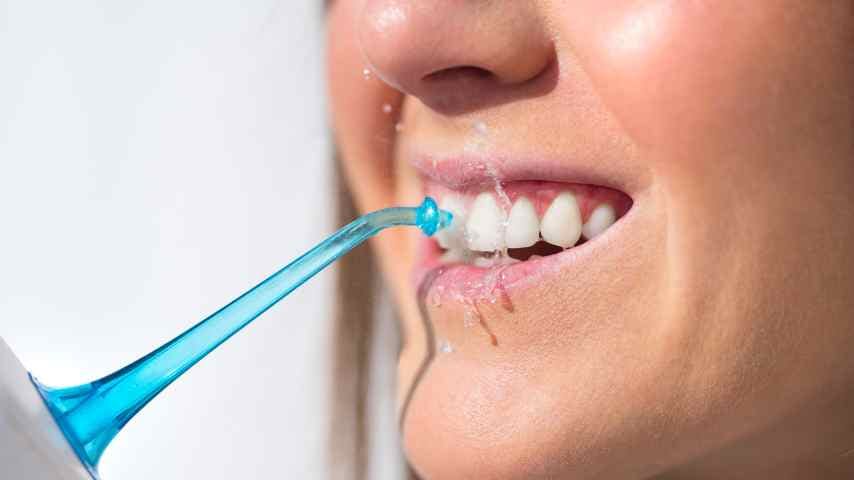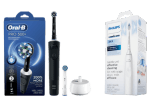Posted by Dr. Taner Cakmak on Thu, 8 Feb 2024
Explore water flossers vs. traditional flossing, ideal for braces & sensitive gums. Get expert advice from Dr. Taner Cakmak at Kanata South Dental.

A water flosser, also known as an oral irrigator or dental water jet, is a device used to clean between the teeth and along the gumline. It works by directing a stream of pressurized water into the mouth, which helps to remove food particles, plaque, and bacteria from areas that are difficult to reach with traditional flossing. Water flossers are often used as an alternative to traditional dental floss, especially for people with braces, dental implants, or other dental appliances. They are also popular among individuals who have difficulty using regular floss due to dexterity issues or sensitive gums.
What Is The Difference Between Ordinary Floss And Water Floss?
The main difference between ordinary floss and water floss lies in their mechanism of action and how they clean between the teeth and along the gumline:
- Mechanism:
- Ordinary floss: Ordinary dental floss is a thin, string-like material typically made of nylon or Teflon. It is manually inserted between the teeth and moved back and forth to remove plaque and debris.
- Water floss: A water flosser, on the other hand, uses a pressurized stream of water to clean between teeth and along the gumline. The water jet is directed into the spaces between teeth and along the gumline, flushing out debris and bacteria.
- Effectiveness:
- Ordinary floss: Traditional flossing with dental floss is highly effective at removing plaque and debris from between teeth and below the gumline when used correctly.
- Water floss: Water flossers can also be effective at removing plaque and debris, particularly in areas that are difficult to reach with ordinary floss. The pulsating water stream can help dislodge food particles and bacteria, providing a gentle massaging effect on the gums.
- Ease of Use:
- Ordinary floss: Requires manual dexterity to maneuver the floss between teeth and may be challenging for some individuals, particularly those with braces or dental appliances.
- Water floss: Water flossers are generally easier to use, requiring less manual dexterity. They can be particularly beneficial for people with orthodontic appliances, implants, or sensitive gums.
- Additional Features:
- Some water flosser models may come with additional features such as adjustable pressure settings, interchangeable tips for different cleaning needs, and built-in timers or reservoirs for added convenience.
Overall, both ordinary floss and water floss can be effective tools for maintaining good oral hygiene. The choice between them often comes down to personal preference, comfort, and individual dental needs. Some people may find that incorporating both methods into their oral hygiene routine provides the best results.
Type Of Water Flosser
There are generally two main types of water flossers available on the market:
- Countertop Water Flossers: These are larger, more powerful water flossers that are designed to sit on a countertop or bathroom vanity. They typically have a larger water reservoir and may offer more features such as adjustable pressure settings, multiple tips, and advanced cleaning modes. Countertop water flossers are usually plugged into an electrical outlet for power and are ideal for home use.
- Cordless Water Flossers: Cordless water flossers are smaller, more portable devices that operate on rechargeable batteries. They are designed for convenience and can be used anywhere without needing to be near an electrical outlet. Cordless water flossers are compact and travel-friendly, making them suitable for use at home, at work, or while travelling.
Both types of water flossers effectively clean between teeth and along the gumline by directing a stream of pressurized water into the mouth. The choice between a countertop and cordless water flosser often comes down to personal preference, lifestyle, and specific oral hygiene needs. Some people may prefer the convenience of a cordless water flosser for travel, while others may appreciate the additional features and power of a countertop water flosser for daily use at home.
Which One Is Better Water Flossing Or Regular Flossing?
Determining which method is "better," whether water flossing or regular flossing, can depend on various factors, including individual preferences, oral health needs, and effectiveness in achieving desired outcomes. Here's a breakdown:
- Effectiveness:
- Both water flossing and regular flossing can effectively remove plaque and debris from between teeth and along the gumline when performed correctly.
- Regular flossing can be particularly effective at physically scraping plaque off the teeth and disrupting bacteria in hard-to-reach areas.
- Water flossing may offer advantages in reaching areas that are difficult to access with traditional floss, such as around dental implants, braces, or bridges. The pulsating water can help dislodge debris and bacteria.
- Ease of Use:
- Water flossers are generally easier to use for individuals with limited manual dexterity or those who find traditional flossing uncomfortable.
- Regular flossing requires manual dexterity to maneuver the floss between teeth and can be challenging for some individuals, especially those with braces or tight spaces between teeth.
- Comfort:
- Some people find water flossing to be more comfortable and less irritating to the gums compared to traditional flossing, especially if they have sensitive gums.
- Others may prefer the familiarity and simplicity of regular flossing and find it more comfortable for their oral care routine.
- Cost and Convenience:
- Water flossers typically involve an initial investment in purchasing the device, but ongoing costs may be lower compared to buying traditional floss.
- Regular flossing is generally more affordable and portable, making it convenient for travel or on-the-go use.
- Compliance:
- The effectiveness of either method ultimately depends on consistent and proper use. Some individuals may be more likely to use one method consistently over the other, leading to better outcomes for their oral health.
Do You Need Water Floseer?
Both water flossing and regular flossing can be effective components of an oral hygiene routine. The "better" option depends on individual preferences, oral health needs, and factors such as ease of use and compliance. Some people may find that a combination of both methods provides the most comprehensive oral care. If you would like to get detailed information please call us Dr.Taner Cakmak and his professional team would be happy to determine the most suitable approach for your specific oral health needs.
Dentist Kanata
We will gladly answer any questions you may have.
Ask QuestionsKanata South Dental offers the ability to request your dentist appointments online. Schedule an appointment now!
Book OnlineBy filling out the New Patient Forms ahead of time you will save significant time on your visit.
New Patient FormsLatest News
Veneers vs. Implants: What's the Difference and Which One is Right for You?
Fri, 17 Oct 2025If you're looking to improve your smile, you’ve probably come across two popular dental treatments: veneers and implants. While both can make a big differen...
Continue Reading